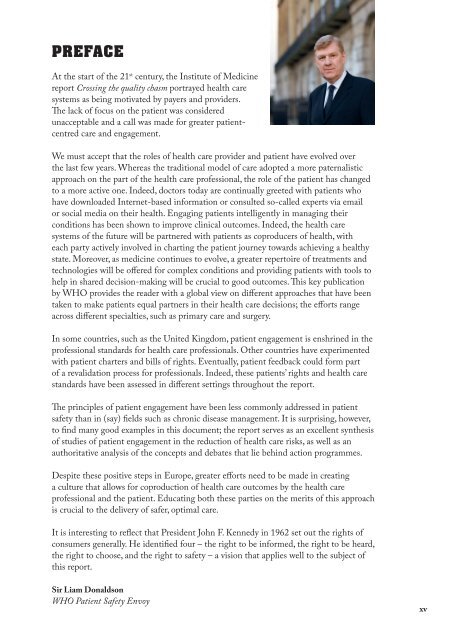Exploring patient participation in reducing health-care-related safety risks
Exploring patient participation in reducing health-care-related safety risks
Exploring patient participation in reducing health-care-related safety risks
You also want an ePaper? Increase the reach of your titles
YUMPU automatically turns print PDFs into web optimized ePapers that Google loves.
pREFACE<br />
At the start of the 21 st century, the Institute of Medic<strong>in</strong>e<br />
report Cross<strong>in</strong>g the quality chasm portrayed <strong>health</strong> <strong>care</strong><br />
systems as be<strong>in</strong>g motivated by payers and providers.<br />
The lack of focus on the <strong>patient</strong> was considered<br />
unacceptable and a call was made for greater <strong>patient</strong>centred<br />
<strong>care</strong> and engagement.<br />
We must accept that the roles of <strong>health</strong> <strong>care</strong> provider and <strong>patient</strong> have evolved over<br />
the last few years. Whereas the traditional model of <strong>care</strong> adopted a more paternalistic<br />
approach on the part of the <strong>health</strong> <strong>care</strong> professional, the role of the <strong>patient</strong> has changed<br />
to a more active one. Indeed, doctors today are cont<strong>in</strong>ually greeted with <strong>patient</strong>s who<br />
have downloaded Internet-based <strong>in</strong>formation or consulted so-called experts via email<br />
or social media on their <strong>health</strong>. Engag<strong>in</strong>g <strong>patient</strong>s <strong>in</strong>telligently <strong>in</strong> manag<strong>in</strong>g their<br />
conditions has been shown to improve cl<strong>in</strong>ical outcomes. Indeed, the <strong>health</strong> <strong>care</strong><br />
systems of the future will be partnered with <strong>patient</strong>s as coproducers of <strong>health</strong>, with<br />
each party actively <strong>in</strong>volved <strong>in</strong> chart<strong>in</strong>g the <strong>patient</strong> journey towards achiev<strong>in</strong>g a <strong>health</strong>y<br />
state. Moreover, as medic<strong>in</strong>e cont<strong>in</strong>ues to evolve, a greater repertoire of treatments and<br />
technologies will be offered for complex conditions and provid<strong>in</strong>g <strong>patient</strong>s with tools to<br />
help <strong>in</strong> shared decision-mak<strong>in</strong>g will be crucial to good outcomes. This key publication<br />
by WHO provides the reader with a global view on different approaches that have been<br />
taken to make <strong>patient</strong>s equal partners <strong>in</strong> their <strong>health</strong> <strong>care</strong> decisions; the efforts range<br />
across different specialties, such as primary <strong>care</strong> and surgery.<br />
In some countries, such as the United K<strong>in</strong>gdom, <strong>patient</strong> engagement is enshr<strong>in</strong>ed <strong>in</strong> the<br />
professional standards for <strong>health</strong> <strong>care</strong> professionals. Other countries have experimented<br />
with <strong>patient</strong> charters and bills of rights. Eventually, <strong>patient</strong> feedback could form part<br />
of a revalidation process for professionals. Indeed, these <strong>patient</strong>s’ rights and <strong>health</strong> <strong>care</strong><br />
standards have been assessed <strong>in</strong> different sett<strong>in</strong>gs throughout the report.<br />
The pr<strong>in</strong>ciples of <strong>patient</strong> engagement have been less commonly addressed <strong>in</strong> <strong>patient</strong><br />
<strong>safety</strong> than <strong>in</strong> (say) fields such as chronic disease management. It is surpris<strong>in</strong>g, however,<br />
to f<strong>in</strong>d many good examples <strong>in</strong> this document; the report serves as an excellent synthesis<br />
of studies of <strong>patient</strong> engagement <strong>in</strong> the reduction of <strong>health</strong> <strong>care</strong> <strong>risks</strong>, as well as an<br />
authoritative analysis of the concepts and debates that lie beh<strong>in</strong>d action programmes.<br />
Despite these positive steps <strong>in</strong> Europe, greater efforts need to be made <strong>in</strong> creat<strong>in</strong>g<br />
a culture that allows for coproduction of <strong>health</strong> <strong>care</strong> outcomes by the <strong>health</strong> <strong>care</strong><br />
professional and the <strong>patient</strong>. Educat<strong>in</strong>g both these parties on the merits of this approach<br />
is crucial to the delivery of safer, optimal <strong>care</strong>.<br />
It is <strong>in</strong>terest<strong>in</strong>g to reflect that President John F. Kennedy <strong>in</strong> 1962 set out the rights of<br />
consumers generally. He identified four – the right to be <strong>in</strong>formed, the right to be heard,<br />
the right to choose, and the right to <strong>safety</strong> – a vision that applies well to the subject of<br />
this report.<br />
Sir Liam Donaldson<br />
WHO Patient Safety Envoy<br />
xv



